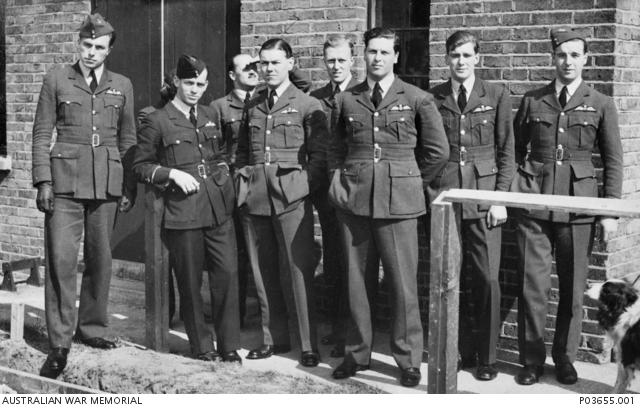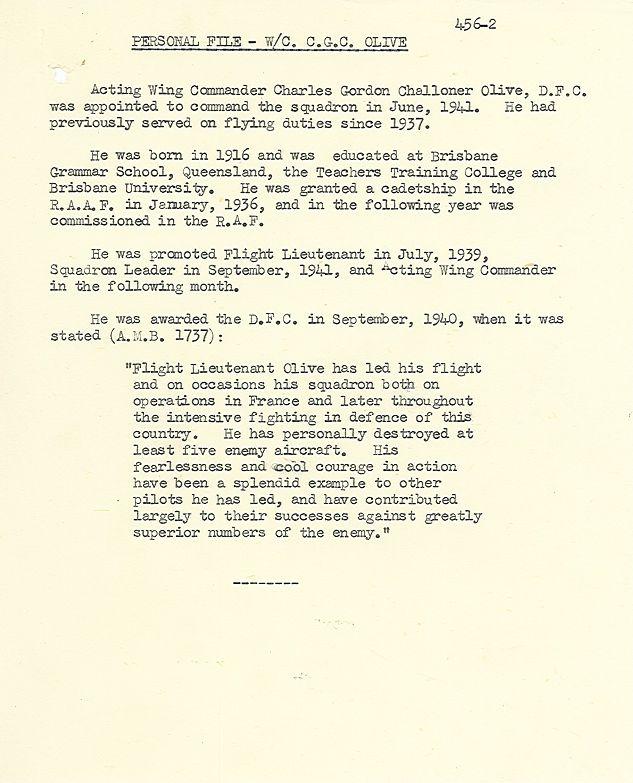RAAF Biographical Files from the Second World War
At the outbreak of the Second World War, there were some 450 Australians serving with the Royal Air Force (RAF) on short-term commissions. Once the Empire Air Training Scheme got underway, thousands more Australians arrived in Britain. Many of them were posted to Royal Air Force squadrons, even though they were members of the Royal Australian Air Force (RAAF).
As these Australians were serving with the RAF, many of the important records usually used to research someone’s service, such as squadron records, are held in Britain rather than Australia. This can make it difficult if you are based in Australia to trace an individual’s career using archival records.
Fortunately, in 1943 RAAF Overseas Headquarters began to compile biographical files of some of its personnel serving in Britain. Their purpose was to collect historical information on Australians serving in the RAAF, RAF and Royal Air Force Volunteer Reserve who achieved distinction, and they were to be used by the RAAF Historical Records Section. These records are now held at the Australian War Memorial in the archival series AWM65. The files include a basic survey that collects the airman's personal information and details of operations, decorations, previous service experience and sometimes details of squadrons and aircraft. The records can also include press releases and newspaper cuttings, debriefs, transcripts of interviews and any form of publicity such as Air Ministry or RAAF bulletins, scripts of BBC "Calling Australia" broadcasts and newspaper reports.
One particularly interesting file is about Charles Gordon Chaloner Olive (AWM65 4018). Gordon Olive was a civil engineering cadet in Brisbane when he joined the RAAF. He trained at Point Cook and took up a short service commission in the RAF in 1937. At the outbreak of the Second World War, Olive was a Flying Officer in 65 Squadron. He became one of the small number of Australian pilots who participated in both the evacuation at Dunkirk and, later, the Battle of Britain.

Informal group portrait of pilots from 65 Squadron, RAF. Identified, second from left, 017934 Pilot Officer (PO) Gordon Olive, and sixth from left 40052 PO John Connolly (Jack) Kennedy.
Olive's file tells us many details we wouldn't usually find in other official records, such as his success as an athlete, breaking the RAF javelin record in 1939. Transcripts of radio interviews share his experiences as a fighter pilot in the Battle of Britain, and recount the respect he had for his fellow pilots, British, Dominion, and Polish alike.
Olive won the Distinguished Flying Cross in September 1940. At the age of just 24, he became the first Commanding Officer of 456 Squadron, the RAAF’s only night fighter squadron in the Second World War. He rose to the rank of Acting Wing Commander, and rejoined the RAAF in 1943.

Olive used to tell his pilots the tale of a particularly memorable incident. Once when he bailed out, his parachute nearly failed to open. When he landed in a paddock, he was confronted by members of the land army and home guard, and had to convince them he was not German. That accomplished, he thought he'd made it, but the ambulance taking him back to the aerodrome overturned and, as the file notes:
I scrambled out with a few more bruises, and was then picked up by a fire engine dashing to the spot where my Spitfire was burning itself out. "The fire engine, too, ended up a minute later in the ditch. "After that, I decided to walk." And that is why the wing commander always tells his pilots that they are safer in the air.
Olive's biography, The Devil at 6 O'Clock: An Australian Ace in the Battle of Britain, was published in 2001. His biographical file and over 4,600 others can be viewed in the Memorial’s Research Centre.
References and Further Reading
- 'Olive, Charles Gordon Chaloner 39469', Australian War Memorial, AWM65 4018.
- 277457 Wing Commander Charles Gordon Chaloner Olive, DFC.
- John Herington, Air War Against Germany and Italy, 1939-1943, Australia in the War of 1939-1945, Series 3 (Air), vol. III (Canberra: Australian War Memorial, 1954).
- Dennis Newton, A Few of 'The Few': Australians and the Battle of Britain (Canberra: Australian War Memorial, 1990).
- Gordon Olive and Dennis Newton, The Devil at 6 O'Clock: An Australian Ace in the Battle of Britain (Loftus: Australian Military History Publications, 2001).
- Series note, AWM65.
- Alan Stephens, The Royal Australian Air Force, The Australian Centenary History of Defence, vol. II (Melbourne: Oxford University Press, 2001).